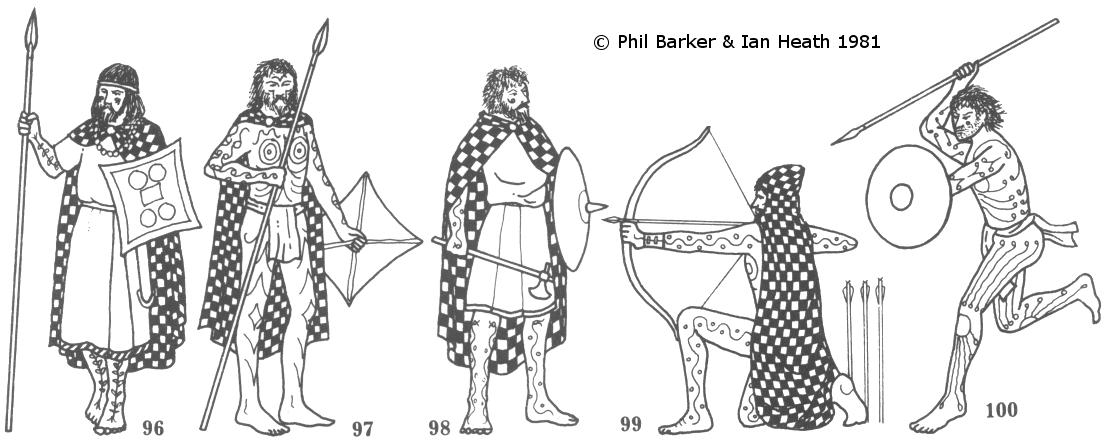
Amazon Audible Gift Memberships
PICTISH INFANTRY
An extract from The Armies and Enemies of Imperial Romeby Phil Barker & Ian Heath
 | ||||
| [Based on Pictish stones] | ||||
96, 97, 98, 99 & 100. PICTISH INFANTRY

 | ||||
| [Based on Pictish stones] | ||||
The Picts were a confederacy of tribes which absorbed those previously known as Caledones during the 3rd century. Their cultural pattern seems to have spread from the north east of modern Scotland, possibly from the Orkneys. They favoured coastal sites, which during the earlier part of their expansion they fortified with the large circular stone towers called "Brochs", and used skin boats for transport and raiding. Excavation of Brochs and the wheel houses that tended to replace them shows that the Picts were very short of metals and had extremely insanitary habits. However, they were extremely artistic and left many rock carvings from which these illustrations are taken.
"Picti" means painted. I interpret this to mean tattooed or painted with woad designs, rather than with woad smeared all over, partly from a reference in Claudian, and partly because other ancient peoples such as the Thracians and Skythians are known to have done this. Woad gives a blue-green dye, and whorls like those depicted would have been as effective as the smudges of pigment on the cheekbones of a modern soldier at hiding the pink of the naked body. There is also a magical reason for its use, as the leaves of the plant are shaped like arrowheads, giving it great protective value against arrows!
The most important article of clothing was a large cloak, which from later practise in that area I suggest was woven in an elaborate check or tartan pattern of the tweedy colours associated with vegetable dyes. This would have provided excellent camouflage, and the pose of 99 suggests that it was used in that way. Rich men might have a shirt dyed with saffron from Crocuses, producing a light yellow original colour. Others made do with cloak and loin cloth. Very few wore shoes.
All Picts old enough to be hairy had long hair, moustaches and straggling pointed beards. All hair colours were found among them, red being quite common. Complexions were generally fair. Unlike the Scots, they combed their hair.
96 is a chieftain from a dark age grave at the Brough of Birsay on Orkney. His tunic has a patterned edge and he wears a short sword. His shield is of the square shape that will be described later, and bears the only patterned design known. He wears a heavy silver chain around his neck, and as late as the 3rd century at least, could fight from a chariot.
97 is a rank and file warrior. His only weapon except for a knife is a long thrusting spear which is shown on one stone being held underarm in two hands to keep off some rather Roman looking cavalry. His square shield is of hide stretched on two crossed sticks held at the juncture.
98 is another wealthy warrior in a yellow shirt, armed with a short axe and carrying a more advanced type of shield. This is still of hide, but circular, convex and embellished with a spike.
99 is an archer lurking in ambush portrayed on another stone. The Picts were unique among the Celtic peoples in making extensive use of the bow. This was relatively small and weak, and the flint arrow heads, while more effective than iron against flesh, would have very little penetrating power against armour. However, they may have been poisoned, a common practise among peoples hunting with weak bows. Very surprisingly, there is hard evidence of the Picts using crossbows, both from one of the stones and from two separate archaeological finds. These probably derived from Roman sources, as their use by the later Roman army is mentioned by Vegetius and a hunting version appears on a monument from Roman Gaul. The numbers in Pictish hands were presumably small.
100 is a relative youngster and has discarded his cloak to bound about unencumbered as a skirmisher with javelins.
Two other possible types are omitted for lack of solid evidence. One is an equivalent of the naked fanatics known in other Celtic armies as Gaesati. I have to admit that I see the Picts as a little too dour for such behaviour, a view possibly influenced by the regional preference for clumps of sensible spearmen rather than the sword waving heroes of the Scot-descended west. The other is based on the possibly matrilineal organisation of Pictish society, which led Rosemary Sutcliff, the historical novelist, to postulate a wild band of under-dressed warrior maidens as a possible fighting element!